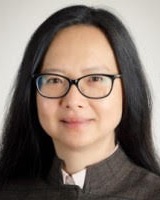TCBG Seminar
From Protein Folding in a Crowd to Higher-order Assemblies in a Cell Tweet

Professor
Margaret Cheung
Physics
University of Washington
Seattle, Washington
Monday, September 13, 2021
3:00 pm (CT)
Zoom webinar recording
Abstract
In order to function, many proteins fold into a well-packed structure, yet the folded phase must remain sufficiently flexible. They form higher-order assemblies, and yet they adapt to perturbation from the surroundings. It is unclear how proteins satisfy these contradictory constraints, especially in the crowded environment of a cell. In the first part of my presentation, I will show that these protein states can coexist by tuning where the protein operates within its temperature-pressure-crowding phase diagram. Working with experimentalists who provide tools for validation, we successfully predicted many emergent features of a protein, including critical points, in a crowded environment with coarse-grained molecular simulations and advanced theories. Our findings suggest that by being near a critical point at physiologic conditions confers an advantage for enzymatic function because such a protein can sample widely different conformations without passing a costly thermodynamic barrier. To further understand how proteins form into higher-order complexes in response to functional cues, we developed a method to infer key chemical information that reproduces the concentrations of the different types of proteins found in experiments. Using this new method, we discovered that distinct cell types have unique protein cluster formation. Therefore, signatures of these protein clusters may be used as plausible biomarkers for predicting the phenotype of a cell. In the second part of my presentation, I will discuss the active role of calmodulin-dependent kinase II (CaMKII) in organizing the structure and dynamics of actomyosin networks in a dendritic spine. I will show how a chemical reaction triggered by calcium binding to calmodulin (CaM) transmits a designated mechanical response across actomyosin network on a micron scale by using an integrative approach of quantum mechanical calculations, non-equilibrium statistical physics, and molecular and mesoscopic simulations. In summary, the long-term goal of my research is to investigate the emergent structures and dynamics of higher-order protein assemblies in a cell and how these protein assemblies actively regulate the cell’s state.



